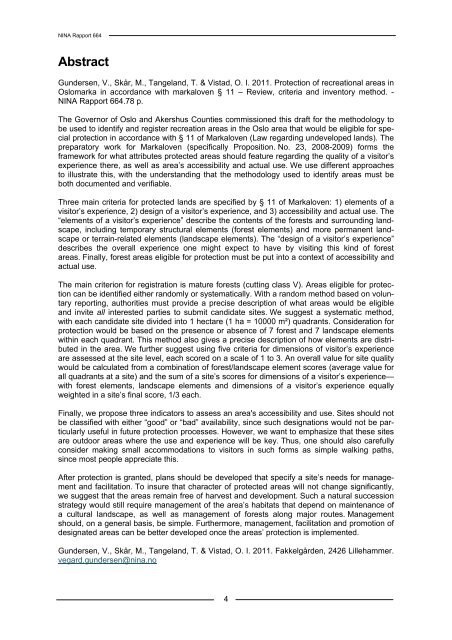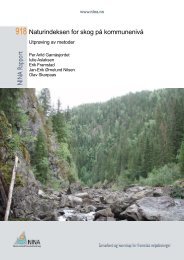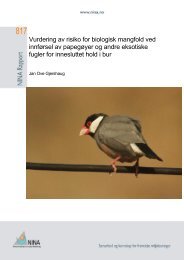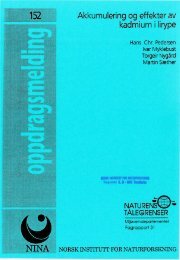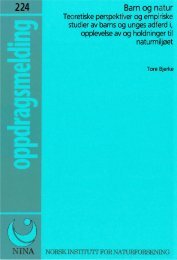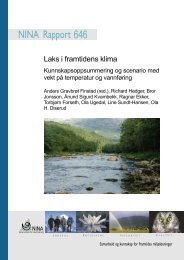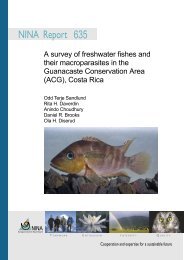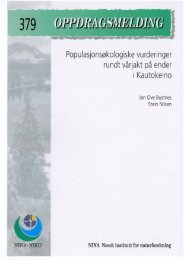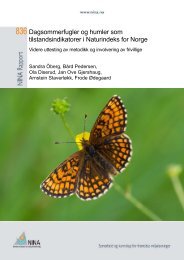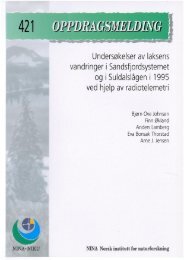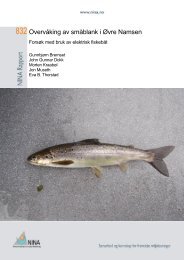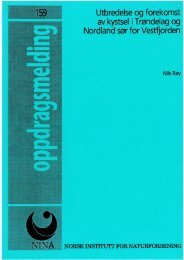Særskilt vern av friluftsområder i Oslomarka etter ... - NINA
Særskilt vern av friluftsområder i Oslomarka etter ... - NINA
Særskilt vern av friluftsområder i Oslomarka etter ... - NINA
You also want an ePaper? Increase the reach of your titles
YUMPU automatically turns print PDFs into web optimized ePapers that Google loves.
<strong>NINA</strong> Rapport 664<br />
Abstract<br />
Gundersen, V., Skår, M., Tangeland, T. & Vistad, O. I. 2011. Protection of recreational areas in<br />
<strong>Oslomarka</strong> in accordance with markaloven § 11 – Review, criteria and inventory method. -<br />
<strong>NINA</strong> Rapport 664.78 p.<br />
The Go<strong>vern</strong>or of Oslo and Akershus Counties commissioned this draft for the methodology to<br />
be used to identify and register recreation areas in the Oslo area that would be eligible for special<br />
protection in accordance with § 11 of Markaloven (Law regarding undeveloped lands). The<br />
preparatory work for Markaloven (specifically Proposition. No. 23, 2008-2009) forms the<br />
framework for what attributes protected areas should feature regarding the quality of a visitor’s<br />
experience there, as well as area’s accessibility and actual use. We use different approaches<br />
to illustrate this, with the understanding that the methodology used to identify areas must be<br />
both documented and verifiable.<br />
Three main criteria for protected lands are specified by § 11 of Markaloven: 1) elements of a<br />
visitor’s experience, 2) design of a visitor’s experience, and 3) accessibility and actual use. The<br />
“elements of a visitor’s experience” describe the contents of the forests and surrounding landscape,<br />
including temporary structural elements (forest elements) and more permanent landscape<br />
or terrain-related elements (landscape elements). The “design of a visitor’s experience”<br />
describes the overall experience one might expect to h<strong>av</strong>e by visiting this kind of forest<br />
areas. Finally, forest areas eligible for protection must be put into a context of accessibility and<br />
actual use.<br />
The main criterion for registration is mature forests (cutting class V). Areas eligible for protection<br />
can be identified either randomly or systematically. With a random method based on voluntary<br />
reporting, authorities must provide a precise description of what areas would be eligible<br />
and invite all interested parties to submit candidate sites. We suggest a systematic method,<br />
with each candidate site divided into 1 hectare (1 ha = 10000 m²) quadrants. Consideration for<br />
protection would be based on the presence or absence of 7 forest and 7 landscape elements<br />
within each quadrant. This method also gives a precise description of how elements are distributed<br />
in the area. We further suggest using five criteria for dimensions of visitor’s experience<br />
are assessed at the site level, each scored on a scale of 1 to 3. An overall value for site quality<br />
would be calculated from a combination of forest/landscape element scores (<strong>av</strong>erage value for<br />
all quadrants at a site) and the sum of a site’s scores for dimensions of a visitor’s experience—<br />
with forest elements, landscape elements and dimensions of a visitor’s experience equally<br />
weighted in a site’s final score, 1/3 each.<br />
Finally, we propose three indicators to assess an area's accessibility and use. Sites should not<br />
be classified with either “good” or “bad” <strong>av</strong>ailability, since such designations would not be particularly<br />
useful in future protection processes. However, we want to emphasize that these sites<br />
are outdoor areas where the use and experience will be key. Thus, one should also carefully<br />
consider making small accommodations to visitors in such forms as simple walking paths,<br />
since most people appreciate this.<br />
After protection is granted, plans should be developed that specify a site’s needs for management<br />
and facilitation. To insure that character of protected areas will not change significantly,<br />
we suggest that the areas remain free of harvest and development. Such a natural succession<br />
strategy would still require management of the area’s habitats that depend on maintenance of<br />
a cultural landscape, as well as management of forests along major routes. Management<br />
should, on a general basis, be simple. Furthermore, management, facilitation and promotion of<br />
designated areas can be b<strong>etter</strong> developed once the areas’ protection is implemented.<br />
Gundersen, V., Skår, M., Tangeland, T. & Vistad, O. I. 2011. Fakkelgården, 2426 Lillehammer.<br />
vegard.gundersen@nina.no<br />
4


